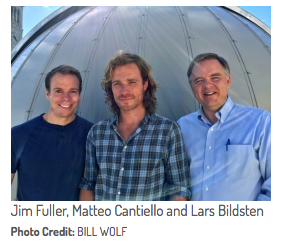Researchers at UCSB’s Kavli Institute for Theoretical Physics develop a new technique to detect magnetic fields inside stars
 (Santa Barbara, Calif.) - For the first time, astrophysicists are able to determine the presence of strong magnetic fields deep inside pulsating giant stars. Magnetic fields have important consequences in all stages of stellar evolution, from a star’s formation to its demise.
(Santa Barbara, Calif.) - For the first time, astrophysicists are able to determine the presence of strong magnetic fields deep inside pulsating giant stars. Magnetic fields have important consequences in all stages of stellar evolution, from a star’s formation to its demise.
A consortium of international researchers, including several from UC Santa Barbara’s Kavli Institute for Theoretical Physics (KITP), used asteroseismology - a discipline similar to seismology - to track waves traveling through stars in order to determine their inner properties. Their findings appear in the journal Science.
"We can now probe regions of the star that were previously hidden," said co-lead author Matteo Cantiello, a specialist in stellar astrophysics at KITP. "The technique is analogous to a medical ultrasound, which uses sound waves to image otherwise invisible parts of the human body."
Cantiello's curiosity and that of his co-authors was sparked when astrophysicist Dennis Stello of the University of Sydney presented puzzling data from the Kepler satellite, a space telescope that measures stellar brightness variations with very high precision. Cantiello, KITP director Lars Bildsten and Jim Fuller, a postdoctoral fellow at the California Institute of Technology, agreed that this was a mystery worth solving. After much debate, many calculations and the additional involvement of Rafael García, a staff scientist at France’s Commissariat à l’Énergie Atomique, a solution emerged. The data were explained by the presence of strong magnetic fields in the inner regions of these stars.
